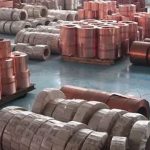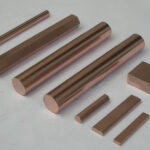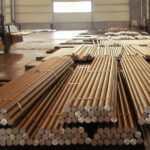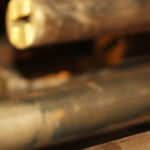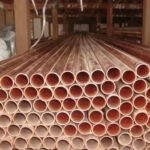Deprecated: get_settings is deprecated since version 2.1.0! Use get_option() instead. in /www/sites/alloy.wiki/index/wp-includes/functions.php on line 4862
Copper is one of the earliest metals discovered by mankind, and it is also the first metal that mankind began to use. The copper beads made of natural copper discovered by archaeologists in northern Iraq are estimated to be more than 10,000 years old.
The earliest bronzes appeared in the Mesopotamia Valley of Babylon 6000 years ago. The large bronze sword with the image of a lion during the Sumerian civilization is a representative of early bronzes.
In China, 5000-4000 years ago, it is equivalent to the legendary age of Yao, Shun and Yu. It is recorded in ancient documents that people had begun to smelt bronzes at that time.
The earliest method of extracting copper was to use natural copper compounds to obtain hydrometallurgical copper. This is not only the origin of wet technique, but also an invention in the history of world chemistry.
Chinese bronze ware mainly refers to bronze wares made of copper and tin more than 4,000 years ago. At that time, as the objects made of copper were too soft, flexible, and blunt quickly, people discovered that tin was mixed into copper to make copper. Tin alloy-bronze, so its hardness has been greatly improved (if the hardness value of tin is set to 5, then the hardness of copper is 30, and the hardness of bronze is 100-150).
The single-edged bronze knife unearthed at the Majiayao cultural site in Gansu is the oldest known bronze ware in my country, and it is also the oldest bronze knife in the world. Approximately 5000 years ago by carbon-14 identification.
In our country, the Xia Dynasty 4,000 years ago began to use red copper, that is, natural copper that was forged and hammered. In 1957 and 1959, nearly 20 bronze wares were excavated at the site of Huangniangniangtai in Wuwei, Gansu twice. After analysis, the copper content in the bronzes was as high as 99.63% to 99.87%, all of which were pure copper.
For pure copper machining, although the mineable deposits were relatively rare in ancient times, it was not difficult to extract from its ore. In the 13th century, the copper method used by the copper mine in Falun, Sweden, was to bake sulfide ore. After the copper sulfate is separated by water, the copper will precipitate when it flows over the surface of the iron filings, and the formed thin layer is easy to separate. This was the huge source of wealth in Falun, Sweden at that time.
Before the Spring and Autumn and Warring States period, people mainly used metal weighing currency in economic activities. Because there is no uniform specification, metal weighing currency is inconvenient to use. Every transaction needs to be divided and identified, and it is difficult to adapt to the increasingly prosperous business activities.
People urgently need a currency that can be universally used, has a uniform specification, and has a lower unit value to meet the needs of daily circulation. Iron is too easy to rust, and gold is too precious and scarce, so copper was once again selected and became the protagonist of this era.
After Qin Shihuang unified China, he also unified the currency. The ancients believed that the sky was round and the earth was square. Qin Shihuang took this as a model, and at the same time used “half two” as a unit to cast round copper coins with square holes and inscribed “half two”.
Since then, this kind of money made of round holes has been used for more than two thousand years, until the period of the Republic of China. Although each dynasty has its own regulations on the weight and writing of copper coins, the overall appearance has not changed much. Copper is therefore firmly tied to money, and the “smelly copper” is also used to refer to money.
Bronze ware produced in the middle and late Qing Dynasty and the Republic of China. During this period, my country’s bronze ware has moved from luxury goods to the ranks of ordinary daily necessities. The use of bronze ware is very common, and the level of craftsmanship varies.
With the rapid development of non-ferrous metal smelting technology in my country, the purity of copper has been greatly improved, and the texture of modern bronzes is essentially different from ancient bronzes. The texture of modern copperware is mainly red copper, brass and cupronickel. The characteristics of red copper are soft, malleable, and easy to shape; brass is golden in color and magnificent; white copper is hard, crystal clear, and not easy to rust.
The earliest smelter in China was the Shanghai Smelter, which was built in 1912. From then to 1949, China has built Chongqing Smelter, Kunming Smelter and Shenyang Smelter. Copper is mainly used for military equipment.
After the founding of New China, in 1952, the 10,000-ton electrolytic copper plant was abbreviated in Tianjin. On May 1, 1953, China’s first crude smelter was put into operation in Tongling, Anhui, with an annual output of 2,000 tons of blister copper.
In modern industry, copper is widely used in the electric power and electronic industries. By the 1960s, copper used in these two industries accounted for 28%. By 1997, these two industries were still the main areas of copper consumption, accounting for Than 25%. Later, copper was widely used in copper stamping, electrical, light industry, machinery manufacturing, construction industry, transportation and other fields. The copper consumer market has also shifted from European and American countries before 2000 to developing countries such as China, Russia, India, and Brazil after 2000. As far as China is concerned, in the consumption of non-ferrous metal materials, copper is second only to aluminum.
Copper price review
On October 16, 1974, the economic recession caused by the first oil crisis caused the price of copper to fall sharply. It fell below the marginal cost line from 1975 to 1978 and lasted for four years; during the second oil crisis, 1981-1985 The price of copper fell below the marginal cost line again, which lasted for four years; the drastic changes in Eastern Europe in the early 1990s and the global economic crisis caused economic slowdown. Copper prices fell below the marginal cost line again. With the rapid recovery of the global economy, copper prices also quickly recovered Medium; the 1997 Asian financial crisis and the economic downturn in Southeast Asian countries caused copper prices to approach the marginal cost line again; as the United States stimulated the real estate industry to stimulate the overall economy in the later period, copper prices began to rebound in 2003; copper prices began to rise continuously in 2005 Until 2008, the subprime mortgage crisis caused the copper price to plummet. In 2011, copper prices fluctuated closely around macroeconomic events such as China’s economic policy tightening and the European debt crisis. In the second half of 2014, increased supply pressure caused copper prices to fall. Copper prices began to fluctuate based on supply and demand.
The content of copper in the earth’s crust is about 0.01%, and in individual copper deposits, the content of copper can reach 3% to 5%. Copper in nature mostly exists as compounds, namely copper minerals. In 2014, the U.S. Geological Survey conducted an assessment of global copper deposits and found that the proven copper resources contained approximately 2.1 billion tons of copper, and the resources to be explored were expected to contain 3.5 billion tons of copper.
Link to this article:The history of copper
Reprint Statement: If there are no special instructions, all articles on this site are original. Please indicate the source for reprinting:Alloy Wiki,thanks!^^



